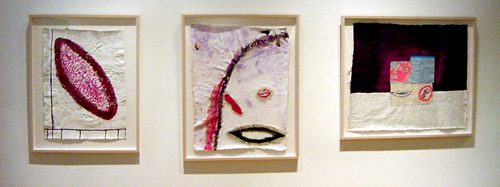|
As early as the 1990s Jungwook
Grace Rim used text which imbued her works with a conceptual
aspect. She also began to examine varying points of view and
positive negative space in her cylinder series drawings that
contain a cylinder/glass that appears less than half full.
Its oval shape drawn on the white paper appears as negative
space that simultaneously because of its outline can be read
as positive. The pictorial space around this form is dotted
with circles and crosses that can be read literally as the
symbols of love and kisses or according to eastern philosophy.
In fact throughout her artistic career Rim utilizes these
elements along with hearts, the oval, and lettering to convey
her feelings as they pertain to the world around her. These
symbols continue to be present in Rim’s oeuvre and represent
her maturity as an artist but they also forecast her future
direction.

From left: Kiss, 29" x 21",
Pencil Thread, Acrylic on Canvas, 2007,
Untitled, 34"x 25", collage, thread, color
pencil, acrylic on canvas,
Working on Peace, 28" x 35", collage, oil,
oil pastel, thread and pencil on canvas
To understand Rim’s work one must know it in its entirety
and with its underlying philosophical framework. It is crucial
to understand that she emigrated to the U.S. from South Korea
and comes from a rich historic culture. Korean society is
very much invested in the ritual and ceremony of four prevalent
religious philosophies; Confucianism that advocates filial
piety, loyalty and is used for state and family organization
and decorum; Buddhism whose goal is the liberation from an
endless cycle of reincarnations and shamanism that is animistic
in its tribal ritualistic nature beliefs; Taoism that is also
animistic but stresses ethics, patience, simplicity, and harmony
and is most likely responsible for the fundamental need in
Korean society for a harmonious existence which led to the
successful combination of all these religions. Rim’s
work embodies these eastern philosophies in her ever present
circles that appear even in her recent works such as Divine
Tent, 2007 done for the tent project in Kassel, Venice and
New York. This beautiful eerily colored blue work with celestial
references contains circles that appear to coalesce on the
top and bottom while dispersing in the middle portion. Because
of its divine allusions these circles can be read as Ensos
that in Japanese means “circles” that is a powerful
Seon sign usually appearing in calligraphy. It symbolizes
strength, the cosmos, spiritual beauty, enlightenment and
emptying of the mind as well as being an expression of the
ephemeral moment which allies it with a gestural art. Buddhist
practice is heavily invested in ritualistic repetition that
according to Seon belief can lead to enlightenment. This aspect
resonates with Rim’s latest works entitled 108 Bows
inspired by her own and her family’s lifelong practice
of bowing. Prostrating oneself 108 times according to Rim
means "repenting 108 times" for the sake of cleansing
earthly desires to balance the scales of accumulated karma.
The 29 candy pink photographs concordant with the February
calendar contain prayer beads that are laid out in a chronological
order as if cells that appear to multiply and pile up as the
days pass. They are laid out on the gallery walls like calendar
days and are accompanied by a video depicting this film strip
movement and the aspect of accumulation like the karmic cycle.
Rim’s recent textual references are to Buddhism for
she has been inscribing her works with the Buddhist prayer
'Ban Ya Shim Kyung'. Rim more than ever partakes of cutting
and sewing her elements onto and from canvas. Rim’s
leitmotif the wedge arises from the cylinder series and her
use of cut outs can be seen in Untitled, 2007 a canvas in
white color with green, purple, orange and pink accents. Finally
it must be stated that although Rim’s works can be read
in terms of Eastern philosophies this doesn’t preclude
interpretation by western standards.
|
